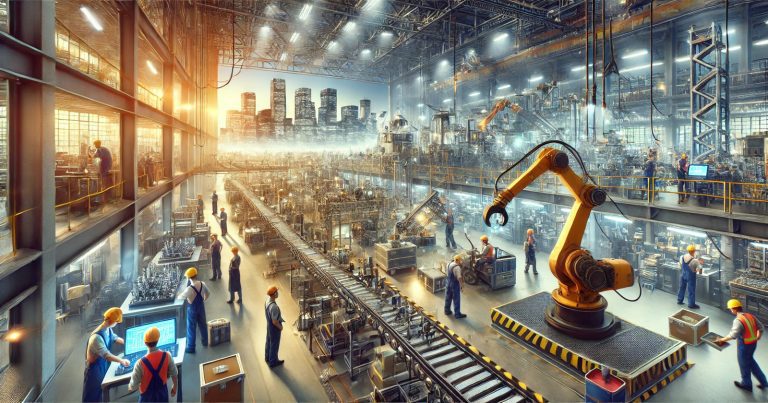Production and employment are the two most essential things for any economy. Production means creating goods and services and providing employment, which enables people to earn a livelihood. These two are interrelated since increased production means increased employment, leading to a better economic status for a country. Production and employment constitute the factors which determine the growth, development, and standard of living of a nation.
There are many sectors that an economy depends upon, give employment and order to earn income. There are three types of industries: primary, secondary, and tertiary. These sectors all provide jobs and income. Employment may also be formal or informal. This variation considers factors like job security, wages, and working conditions. Employment exchange, employment registration, and employment renewal describe the nature of employment and thus analyze job trends in an economy. The backbone of a stable production system that guarantees economic stability is the employer, who hires the workers.
Production and Employment Co-Relate to Each Other
The increase in production increases business. Hence, there is more demand for labourers, which means more employment and vice versa. As soon as the output decreases, businesses lay off some of their workers, leading to increased job loss. This automatically affects the entire economy and, therefore, has a voice in utilising the resources efficiently.
More production will boost employment opportunities in the industries, agricultural sectors, and services. Factories, farms, and businesses need more workers to produce goods and services, leading to a high-income level and purchasing power. Higher incomes also lead to a further demand for higher products, which leads to more increases in production. This is, therefore, favourable for stability and development.
Such technological advances even reduce the need for labour in some cases. Handwork is replaced by machines and automation, thereby reducing employment in these sectors. However, technology also opens new avenues for jobs in new industries, thus balancing the effect. The government itself takes care of production and employment. Employment will be generated in job opportunity generation, investment, and infrastructural development sectors. Most governments declare several schemes with a specific interest in industries and entrepreneurship that can possess skills to generate more employment opportunities.
Economic activity is a definite liaison between production and employment. During prosperity, industrial activities tend to expand while the rate of employment increases owing to improvements in people’s living conditions. During the depression, it tended to cut down production, followed by layoffs and employment. The economic growth must find a balance between production and generating employment.
Sectors of Economy
A healthy economy is divided into sections that manufacture goods and offer jobs. Their sectors determine the type of jobs, wages, and economy. The economy is split into three significant ways:
| Sector | Activities | Employment Nature | Example Jobs |
| Primary | Uses natural resources | Seasonal & informal | Farmer, fisherman, miner |
| Secondary | Manufacturing & construction | Stable & formal | Factory worker, welder, technician |
| Tertiary | Services | Secure & well-paying | Teacher, doctor, banker |
Primary sector
Primary sectors use natural resources. They are more concerned with agriculture, fishing, forestry, and mining. It is an industry where most of the workforce is stationed in developing countries. The farmers, fishermen, and miners all try to sell raw materials directly to them.
Employment in this sector is seasonal. The labourers are mainly employed during harvest times. The mining or fishing industries work with irregular shifts. Employment is informal; hence, wages are not fixed, job security does not exist, and social security for the worker does not prevail. Governments create employment registration schemes to assist labourers in the secondary sector.
Secondary Sector
The secondary sector comprises the manufacturing and industrial sectors. This mainly consists of factories, construction, and production units that generate finished goods from raw materials. For example, it comprises automobile factories, textile industries, and steel plants.
The secondary sector is more stable than the primary sector in terms of employment. There is a fixed wage, and, in general, the job security is much higher. However, many hardships are faced by the industries and labour laws define safety and workers’ rights. Factory owners or employers see that proper working standards exist and give their employees adequate wages.
Tertiary Sector
It encompasses banking services, health and medical care services, education facilities, and even tourism services. It cannot produce tangibles but can produce core services to generate economic activities. Doctors, teachers, bank workers, and software engineers are fallible in this sector.
This sector produces, on average, employment that is both profitable and stable. Much expansion has happened due to the impact of technology and globalisation in this sector. Employees working in this sector are usually enrolled for employment purposes with government offices to receive the advantage of schemes related to employment. The employment exchange allows employment opportunities for the people involved in this ever-expanding sector.
Where Are Most People Employed?
Employment is divided into sectors. Most sectors provide relatively good wages, while others employ people for short-term and informal jobs. The number of people employed in any given sector differs from one country to another depending on whether the country is developing economically or industrialising.
| Sector | Employment Type | Stability | Example Jobs |
| Primary | Seasonal & informal | Low stability | Farmer, fisherman, miner |
| Secondary | Industrial & skilled labour | Moderate stability | Factory worker, electrician, welder |
| Tertiary | Professional & service-based | High stability | Teacher, banker, doctor |
Primary Sector (Agriculture and Natural Resources)
The primary sector constitutes agriculture, fishing, forestry, and mining. In most developing countries, most people are involved in agriculture. Specifically, they raise crops and animals, respectively, whereas the fishermen extract marine products, and the miners extract other minerals.
The jobs in this sector usually differ with seasons. Farming jobs only come at planting and harvest times. For example, the types of jobs that fishermen and miners acquire depend on whether the season is good or bad. The jobs acquired from this sector have fewer security aspects since most of its workers are without employment registration.
Secondary Sector (Manufacturing and Construction)
Factories, industries, and construction work are depicted as the secondary sector. This sector transforms raw materials into a finished product. Examples include textile mills, automobile manufacturing, steel production, and construction projects.
In this sector, employment positions are relatively stable. The employees take home fixed wages. Some jobs also include insurance and pension schemes. On the other hand, factory conditions are sometimes harsh, so government regulations are needed to protect the workers.
Tertiary Sector (Services and Trade)
Jobs in banking, health care, education, retailing, and tourism are included in the tertiary sector. More and more people enter this sector as it offers better wages, job security, and career advancement. Doctors, teachers, IT professionals, and customer service representatives work there.
This industry is growing very fast because of globalisation and technology. Most workers have government-registered employment so that they cannot lose their jobs. Further, the Internet business and other forms of electronic marketing have created more employment opportunities.
Protect Workers in Different Industry Categories of the Economy
In other economic sectors, the employees suffer from low wages, insecurity of employment, dangerous working conditions, and fewer benefits. It will be necessary to protect workers so that employment conditions are just and productive.
Protection of Workers in the Primary Sector
The nature of the work, seasonal factors, and environmental conditions contribute to unstable earnings by farmers, fishermen, and miners. The government should develop policies that will protect these workers.
Subsidiaries and agriculture loans can shield these farmers from financial risks.
Crop failure, accidents, or other natural catastrophes can be insured against. This will help safeguard the income earned by the worker.
Employment registration can be encouraged so that workers can also benefit from government benefits and social security.
Protect the Employees in the Secondary Sector
The factory and construction workers are known to be subjected to hazardous situations with exposure to peril. The employers should work on improving the working environment.
Strict labour laws will be enacted to prevent exploitation and ensure equal wages.
Proper safety training and proper equipment will lead to fewer accidents in the workplace.
Enforcing regular health checkups and limiting working hours will benefit employees’ well-being.
Protect the Employees in the Tertiary Sector
The service sector employees are different. The challenges here are job stress and unfair wages. Therefore, the law should ensure that the employer provides just treatment.
Implementation of minimum wage laws can deter salary exploitation.
Facilitating legal protection of workers against unfair job termination can improve job security.
Employee’s motivation Realistic promotion chances and career development opportunities
GDP and its Functions in Production and Employment
Gross Domestic Product is the total goods and services produced within a country. It’s one of the essential measures for economic growth and its relevance to production and employment relationships.
- An increasing GDP leads to more production and, hence, more jobs. With the expansion of industries and businesses, more people are recruited, incomes rise, and living standards improve. On the other hand, a declining GDP signals an economic slowdown, reduces employment, and decreases people’s income.
- The influence of various factors on the country’s GDP in the growth of industrial production, agriculture productivity, and services development. The policy of investments or business growth positively favours better GDP growth, and more people can be engaged through employment. This is one trend that government strategies are often measured against so they can help financially ailing sectors.
- When the GDP is high, businesses go well, people earn more, and there is a higher demand for goods and services. This is bound to engender a positive cycle in production and employment. A low GDP affects the firm negatively and results in layoffs and job loss. Therefore, maintaining a stable GDP has become essential for economic progress.
Key Facts Every Worker Must Know
Workers in any line of work must learn about the workplace. Workers should understand job security, wages, rights, and job opportunities to improve their professional careers.
- Employees must be informed about the type of employment they are under. A few employments pay fixed salaries with benefits, while others provide only temporary income. Knowing the meaning of employment and understanding a contract of employment guides an employee in making good choices in his career.
- Employment exchange services guide the seekers in getting proper job opportunities. The government offers employment banks and monetary aid to unemployed individuals so they can survive through the transitional phases of job shifts. Employment renewal is essential for employees working on contracts to ensure workflow continuity.
- Labourers must be better informed about their employer’s policy and labour law. The employer offers jobs and guarantees equal wages, job security, and safety on job sites. Labourers should be cognizant of their rights and challenge society to fight for fair treatment in the workplace.
- Training and skill upgradation are also essential in today’s competitive job market. As the industries change, employees must upgrade themselves accordingly to keep them relevant. Governments and private organisations offer various skill up-gradation programs for employment opportunities.
Production and EmploymentFAQs
1. What is the relationship of production with employment?
Production and employment are directly proportional. The more production there is, the more employment there is, and vice versa. The more production there is, the more employment there is, and vice versa. Economic growth depends on maintaining a balance between these two factors.
2. What does the nature of employment mean?
Nature of employment refers to the type of job a person has, including its stability, wages, benefits, and job security. It determines whether employment is formal, informal, contractual, or permanent.
3. What are the advantages of job registration for the applicant?
Employment registration allows job seekers to fill government and private job openings. It records the status of job vacancies, skill levels, and future career prospects in diverse industries.
4. What is an employment exchange?
An employment exchange is a government service that assists job seekers in finding employment that is appropriate to their needs. It connects the employer with potential employees, promoting better job placement.
5. What is the employer?
An employer is a person or organization that hires workers and pays wages in return for their services. The employers are responsible for fair work conditions, salaries, and job security.


